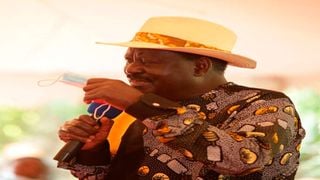
ODM leader Raila Odinga addresses supporters in Migori Town on August 1, 2021.
| Tonny Omondi | Nation Media GroupPolitics
Premium
Raila Odinga faces biggest political test as he seeks to create winning team
Mr Raila Odinga, the enigma that has dominated Kenya’s politics for years, now faces a big test, with analysts suggesting his current political predicament is his weakest in a long time.
For a man who first ran for the presidency in 1997, engineered a walkout from Kanu that hastened the end of the independence party’s nearly four-decade rule, and as a presidential candidate in 2007, 2013 and 2017 was the fulcrum around which opposition politics revolved, he finds himself in unfamiliar territory.
The dissolution of the National Super Alliance (Nasa) followed by the eventual declaration by the One Kenya Alliance team of Musalia Mudavadi, Kalonzo Musyoka, and Moses Wetang’ula that they could only accommodate the ODM leader “if he comes with no conditions of being a flagbearer, but as an equal partner”, complicates Mr Odinga’s game plan.
This is coupled with the fact that an attempt to build an alliance with President Uhuru Kenyatta’s Jubilee Party — seen as the weaker version of the behemoth that roared to power in 2017 — has ran into headwinds, with some ruling party diehards demanding it be called off until the outfit gets its house in order.
But as Mr Odinga charts his own path, releasing snippets of his manifesto ranging from transformation of rural economies, a compulsory universal healthcare programme, a working civil service and promotion of industries for the ‘Made in Kenya’ brands, he appears isolated and struggling to attract allies to his side unlike in the past.
Prof Winnie Mitullah of the University of Nairobi says Mr Odinga, at this point, might be at his weakest politically.
“For Raila, it is a tight space he finds himself in. To a large extent, Raila has been at the top or steering the equation at the top in the past few elections. Now, those dominant in his coalitions in those elections have pulled out and are telling him to join them, only as equals. The alliance with Jubilee, at this point, is also not clear,” Prof Mitullah says.
The don, however, admits that the former prime minister still had some cards to play, with the benefit of time still behind him.
“Raila now has to think outside the box, play out the scenarios. His best chance, it appears, is to equally prop new alliances, eat into his former Nasa partners’ strongholds by propping up different pointmen in their place,” Prof Mitullah says.
Having first run in 1997 and came a distant third behind President Daniel Moi and Mwai Kibaki, Mr Odinga polled his best shot at State House yet in the disputed 2007 poll, with 4.35 million votes against Kibaki’s 4.58 million, but with an impressive 99 MPs against Mr Kibaki’s paltry 43 MPs elected on his party ticket.
Mr Odinga came a commanding second in 2013 with 5.34 million against President Kenyatta’s 6.173 million, while in the annulled 2017 poll, he polled 6.822 million (44 percent) against President Kenyatta's 8.223 million votes (54 per cent).
Given these statistics, Maseno University political science lecturer Tom Mboya argues that even though the OKA principals have the upper hand since they are doing the invitation in the proposed coalition, Mr Odinga can still upend them in their own game.
The don, who described Kenya’s politics as “so dynamic, so fast-moving that it defies predictive explanation,” argues that as it stands, Mr Odinga was the bigger partner in any scenario.
“OKA can be the one inviting ODM and Raila, but in politics, the questions will always boil down to: Are you invaluable? Are you indispensable? Put against Mudavadi, Gideon Moi or Wetang’ula, ODM, and Raila specifically, is the bigger partner,” argues Mr Mboya.
Aga Khan University’s Sam Kamau agrees, saying OKA principals had no bargaining chip against Mr Odinga. “Kalonzo ran for President in 2007 and got around 800,000 votes. Mudavadi ran in 2013 and got close to 500,000 votes. The truth is, without Raila, the duo does not have enough votes to capture the top seat even if they teamed up. At best, they can only deny Ruto or Raila the constitutional threshold of 50 per cent plus one. As things stand, let them extract the best possible bargain and support the stronger candidate. Alternatively, let then run on their own and force a rerun. They cannot continue making demands to be anointed the candidate by the stronger candidates,” Dr Kamau, a communication lecturer who comments on politics, argues.
Mistrust
Mr Mudavadi and Mr Musyoka have both insisted that Mr Odinga had to back one of them for the top job in 2022, citing their working relationships since 2007.
“I do not know who Raila is going to approach individually as his party says, but there is a major sigh of relief among us because it has opened the window for us to freely engage with other Kenyans . . . Anything is possible, but I wonder how the existing mistrust that is just too wide will be bridged,” Mr Mudavadi said of the ODM move to announce planned renegotiation with ex-Nasa partners.
Mr Musyoka, on the other hand, who was Mr Odinga’s running mate in 2013 and 2017, believes it is the former prime minister’s turn to back him for the top job.
ODM secretary general Edwin Sifuna believes there was not much to discuss on who is the most influential politician between them and Mr Odinga.
“We’re not saying we don’t need them. Kura hata moja ni muhimu (every single vote counts). But they are not equals with Raila. We can discuss equity but not equality,” Mr Sifuna said last week.
Mr Odinga has been marshaling his troops with a keen focus on President Kenyatta’s restive Mt Kenya’s eight million vote basket.





